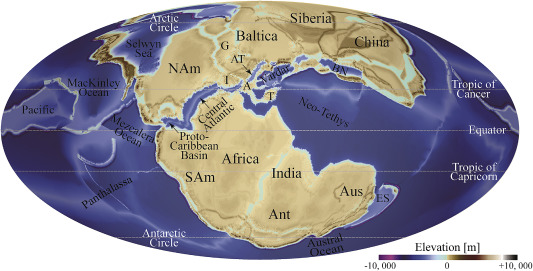
Palaeo-Digital Elevation Model of the Earth at ∼165 Ma applied on the plate tectonic model developed at the University of Lausanne (UNIL) (© Shell Global Solutions International, 2013; version 2010 of the UNIL Plate Model).
story by Helen Hill

This month we look at new work by a team of Swiss researchers who have been using MITgcm to explore the ocean circulation associated with the global land distribution during the Jurassic.
In their recently published paper Modeling the Middle Jurassic ocean circulation, authors Maura Brunetti and Christian Verard (Institute of Environmental Sciences, University of Geneva), and Peter Baumgartner (Institute of Earth Sciences, University of Lausanne) present coupled MITgcm ocean–sea-ice simulations of the Middle Jurassic (∼165 Ma), a time when Laurasia and Gondwana began drifting apart giving rise to the formation of what became the Atlantic Ocean.
Since the opening of the Proto-Caribbean is not well constrained by geological records, the team examine configurations with and without an open connection between the Proto-Caribbean and Panthalassa, the vast global ancestral Pacific ocean that surrounded the supercontinent Pangaea, during the late Paleozoic and the early Mesozoic eras.
Using a sea-floor bathymetry obtained from a recently developed three-dimensional elevation model that compiles geological, palaeogeographical and geophysical data, the authors original approach couples this elevation model, which is based on detailed reconstructions of oceanic realms, with a dynamical ocean circulation model.
Since its curvilinear coordinate system avoids Pole singularities, allowing Polar regions, and in particular the South Pole, which was covered by the Panthalassa Ocean during the Middle Jurassic, to be described, the researchers use the cubed-sphere grid (Adcroft et al., 2004); See Brunetti et al. (2015) for all the computational details.
Among several findings, Brunetti et al observe that the Middle Jurassic bathymetry of the Central Atlantic and Proto-Caribbean seaway only allows for a weak current of the order of 2 Sv in the upper 1000 m even if the system is open to the west. They note that closure of the western boundary of the Proto-Caribbean increases the transport related to barotropic gyres in the southern hemisphere and changes water properties, such as salinity, in the Neo-Tethys. Finally they report weak upwelling rates in the nascent Atlantic Ocean in the presence of this superficial current, which they discuss in the context of compatibility with deep-sea sedimentological records for the region.
The pair of animations below show the intensity and direction of the surface currents for the the last 5 years of an experiment modeled on the period of the Jurassic termed the Callovian with an open connection (Upper Video) and no connection (Lower Video) between the Proto-Caribbean and Panthalassa. Videos credit: C Vérard.
“Open”
“Closed”
To find out more about this work contact Maura.

Maura Brunetti began using MITgcm in 2012. Besides modeling the ancient oceans she is a hiker, she also likes to play guitar as well as travel with her family.

Christian Vérard has also been using MITgcm for the past 3 years. Away from his screen he also enjoys hiking and skiing in the beautiful mountains surrounding Geneva.
This Month’s Featured Publication
- Maura Brunetti, Christian Vérard, Peter O. Baumgartner (2015), Modeling the Middle Jurassic ocean circulation, in press for Journal of Palaeogeography, doi: 10.1016/j.jop.2015.09.001
Other New Publications this Month
K. Castro-Morales, R. Ricker, and R. Gerdes (2015), Snow on Arctic sea ice: model representation and last decade changes, The Cryosphere Discuss., 9, 5681–5718, 2015 www.the-cryosphere-discuss.net/9/5681/2015/, doi: 10.5194/tcd-9-5681-2015
Abhisek Chakraborty, Rashmi Sharma, Raj Kumar, Sujit Basu (2015), Joint assimilation of Aquarius-derived sea surface salinity and AVHRR-derived sea surface temperature in an ocean general circulation model using SEEK filter: Implication for mixed layer depth and barrier layer thickness, Journal of Geophysical Research Oceans, early online edition, doi: 10.1002/2015JC010934
Stephen M. Griffies, Ronald J. Stouffer, Alistair J. Adcroft, Kirk Bryan, Keith W. Dixon, Robert Hallberg, Matthew J. Harrison, Ronald C. Pacanowski, and Anthony Rosati (2015), A Historical Introduction to MOM, NOAA Geophysical Fluid Dynamics Laboratory, Princeton, USA, pdf
Özgür Gürses, Ali Aydoğdu, Nadia Pinardi, Emin Özsoy (2015), Modeling the Turkish Straits System: Circulation and mixing based on inter-basin coupling, Marine Environmental Monitoring, Modelling And Prediction, 47th International Colloquium, Liege, 4-8 May 2015 pdf
Nils Hutter (2015), Viscous Plastic Sea Ice Models at Very High Resolution, Master’s Thesis in the Postgraduate Programme Environmental Physics (PEP), Universitat Bremen, Alfred-Wegener Institute, pdf
Armin Köhl (2015) Influence of assimilating transports and in situ data from the Rapid-MOCHA array into the GECCO2 ocean synthesis, Dynamics of Atmospheres and Oceans, Volume 72, December 2015, Pages 38–51, doi: 10.1016/j.dynatmoce.2015.09.001
Georgy E Manucharyan and Michael A Spall (2015), Wind-driven freshwater buildup and release in the Beaufort Gyre constrained by mesoscale eddies, accepted in Geophysical Research Letters, doi: 10.1002/2015GL065957
Benjamin Peherstorfer and Karen Willcox (2015), Data-driven operator inference for nonintrusive
projection-based model reduction, ACDL Technical Report TR-15-1, pdf
Shanon M. Reckinger, Mark R. Petersen, Scott J. Reckinger (2015), A study of overflow simulations using MPAS-Ocean: Vertical grids, resolution, and viscosity, in press at Ocean Modelling, doi: 10.1016/j.ocemod.2015.09.006
L. Shi, O. Alves, R. Wedd, M. A. Balmaseda, Y. Chang, G. Chepurin, N. Ferry, Y. Fujii, F. Gaillard and 14 more (2015), An assessment of upper ocean salinity content from the Ocean Reanalyses Inter-comparison Project (ORA-IP), online in Climate Dynamics, doi: 10.1007/s00382-015-2868-7
J.N. Stroh, Gleb Panteleev, Sergey Kirillov, Mikhail Makhotin, Natalia Shakhova (2015), Sea surface temperature and salinity product comparison against external in situ data in the Arctic Ocean, accepted in Journal of Geophysical Research Oceans, doi: 10.1002/2015JC011005
Do you have news about research using MITgcm? We are looking for contributions to these pages. If you have an interesting MITgcm project (ocean, atmosphere, sea-ice, physics, biology or otherwise) that you want to tell people about, get in touch. To make a post, contact Helen
